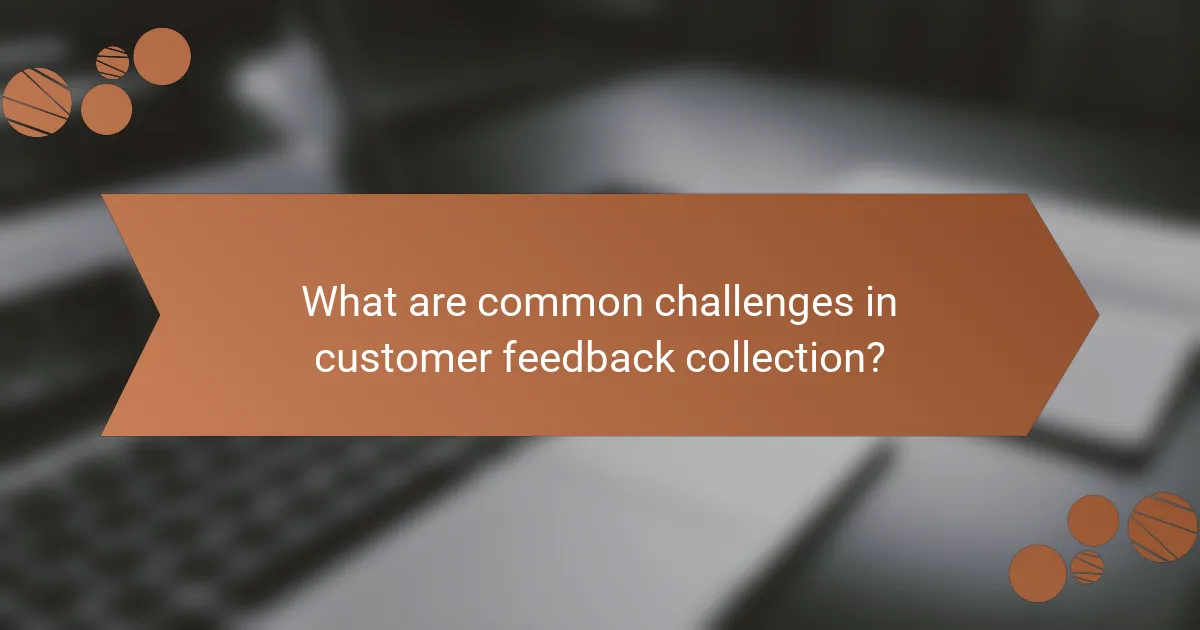Customer feedback plays a crucial role in driving e-commerce success by offering valuable insights into consumer preferences and challenges. By employing effective assessment techniques and measuring key effectiveness metrics, businesses can better understand customer experiences, leading to improved products and enhanced satisfaction. Analyzing feedback not only informs decision-making but also fosters a deeper connection with customers, ultimately boosting sales and loyalty.

How can customer feedback improve e-commerce sales?
Customer feedback is essential for enhancing e-commerce sales as it provides insights into customer preferences, needs, and pain points. By actively collecting and analyzing feedback, businesses can make informed decisions that lead to increased sales and customer satisfaction.
Increased customer loyalty
Gathering customer feedback helps businesses identify what keeps customers coming back. By addressing concerns and implementing suggestions, companies can foster a sense of loyalty among their clientele. For instance, offering personalized responses to feedback can enhance the customer relationship, leading to repeat purchases.
To build loyalty, consider creating a feedback loop where customers see their suggestions implemented. This not only shows that their opinions matter but also encourages them to engage more frequently with your brand.
Enhanced product offerings
Customer feedback provides direct insights into product performance and desired features. By analyzing this feedback, e-commerce businesses can refine existing products or develop new ones that better meet customer needs. For example, if multiple customers request a specific feature, prioritizing its development can lead to increased sales.
Regularly review feedback trends to identify common themes. This can guide product development and ensure that offerings align with market demands, ultimately driving sales growth.
Better customer experience
Improving the customer experience is a direct outcome of utilizing feedback effectively. By understanding customer pain points, businesses can streamline processes, enhance website usability, and provide better customer service. For example, if customers frequently mention difficulties during checkout, addressing these issues can reduce cart abandonment rates.
Implementing changes based on feedback should be a continuous process. Regularly solicit feedback through surveys or reviews and monitor customer satisfaction metrics to ensure ongoing improvements in the customer experience.

What are effective customer feedback assessment techniques?
Effective customer feedback assessment techniques include methods that gather insights directly from customers about their experiences and satisfaction. These techniques help businesses understand customer needs, enhance products or services, and improve overall satisfaction.
Surveys and questionnaires
Surveys and questionnaires are structured tools used to collect customer feedback efficiently. They can be distributed online, via email, or in person, allowing businesses to reach a wide audience quickly. Key considerations include question clarity, length, and the balance between open-ended and closed questions.
For effective surveys, aim for a completion time of under 10 minutes to maintain engagement. Use a mix of quantitative questions (like rating scales) and qualitative questions (like open text) to gather comprehensive insights. A common pitfall is overloading surveys with too many questions, which can lead to lower response rates.
Net Promoter Score (NPS)
The Net Promoter Score (NPS) is a widely used metric that measures customer loyalty and satisfaction based on a single question: “How likely are you to recommend our product/service to a friend or colleague?” Responses are typically rated on a scale from 0 to 10, categorizing customers into promoters, passives, and detractors.
To calculate NPS, subtract the percentage of detractors from the percentage of promoters. A score above 0 is generally considered good, while a score above 50 is excellent. Regularly tracking NPS can help identify trends over time, but it should be complemented with qualitative feedback for deeper insights.
Customer interviews
Customer interviews involve direct, one-on-one conversations with customers to gather in-depth feedback. This qualitative method allows for deeper exploration of customer experiences, motivations, and pain points. Interviews can be conducted in person, over the phone, or via video calls.
When conducting interviews, prepare open-ended questions that encourage detailed responses. Aim for a relaxed atmosphere to foster honest dialogue. A common mistake is to lead the conversation with bias; instead, let customers share their thoughts freely. Consider recording interviews (with permission) for accurate analysis later.

How to measure the effectiveness of customer feedback?
Measuring the effectiveness of customer feedback involves analyzing various metrics that indicate how well feedback is gathered, understood, and acted upon. Key techniques include assessing response rates, conducting sentiment analysis, and tracking actionable insights derived from the feedback.
Response rate analysis
Response rate analysis evaluates the percentage of customers who provide feedback compared to the total number of customers approached. A higher response rate often indicates better engagement and interest in the feedback process.
To improve response rates, consider using incentives, simplifying the feedback process, and ensuring that requests for feedback are timely and relevant. Aim for response rates in the range of 10-30%, depending on the method used, such as surveys or direct outreach.
Sentiment analysis
Sentiment analysis involves evaluating the emotions expressed in customer feedback to gauge overall satisfaction and areas needing improvement. This can be done through text analysis tools that categorize feedback as positive, negative, or neutral.
Utilizing sentiment analysis helps identify trends over time and can inform strategic decisions. Regularly monitor sentiment scores to understand customer perceptions and adjust your approach accordingly.
Actionable insights tracking
Tracking actionable insights focuses on identifying specific feedback that can lead to tangible improvements in products or services. This involves categorizing feedback into themes and prioritizing them based on impact and feasibility.
Establish a system for documenting and reviewing these insights regularly. Create a checklist to ensure that feedback is not only collected but also analyzed and acted upon, fostering a culture of continuous improvement. Aim to implement changes based on customer feedback within a few months to maintain relevance and responsiveness.

What are the best tools for gathering customer feedback?
The best tools for gathering customer feedback include platforms that facilitate surveys, polls, and customer support interactions. These tools help businesses collect valuable insights to improve products and services.
SurveyMonkey
SurveyMonkey is a widely used online survey tool that allows businesses to create customizable surveys quickly. It offers various templates and question types, making it easy to gather specific feedback from customers.
When using SurveyMonkey, consider the target audience and keep surveys concise to improve response rates. A good practice is to limit surveys to 10 questions or less, which can typically be completed in under five minutes.
Qualtrics
Qualtrics is a robust experience management platform that provides advanced survey capabilities and analytics. It is ideal for organizations looking to conduct in-depth research and gather actionable insights.
This tool supports complex survey logic and allows for real-time data analysis. Businesses should leverage its reporting features to track trends and measure customer satisfaction effectively.
Zendesk
Zendesk is primarily a customer service platform that includes feedback collection features through support tickets and customer interactions. It enables businesses to gather feedback directly from customer support channels.
Utilizing Zendesk for feedback can enhance customer experience by addressing issues promptly. Companies should ensure they follow up on feedback received to demonstrate responsiveness and build customer loyalty.

What are common challenges in customer feedback collection?
Customer feedback collection often faces several challenges that can hinder the effectiveness of the process. Key issues include low response rates, bias in responses, and data privacy concerns, each of which can significantly impact the quality and reliability of the feedback obtained.
Low response rates
Low response rates are a frequent challenge in gathering customer feedback, often resulting from survey fatigue or lack of engagement. Many customers may overlook feedback requests, especially if they feel inundated with surveys or if the requests are not timely or relevant.
To improve response rates, consider incentivizing participation with discounts or rewards. Keeping surveys short and focused can also encourage more customers to complete them, as lengthy surveys can deter participation.
Bias in responses
Bias in responses can skew the data collected, leading to inaccurate insights. This bias may stem from leading questions, the survey format, or the demographics of respondents who choose to participate.
To minimize bias, ensure that questions are neutral and straightforward. Using a mix of qualitative and quantitative questions can provide a more balanced view, while random sampling can help capture a more representative segment of your customer base.
Data privacy concerns
Data privacy concerns are increasingly significant in customer feedback collection, as customers are wary of how their information will be used. Regulations such as GDPR in Europe require businesses to handle personal data with care, which can complicate feedback processes.
To address these concerns, be transparent about data usage and ensure compliance with relevant regulations. Providing customers with options to remain anonymous can also encourage more honest feedback, as they feel safer sharing their opinions without fear of repercussions.

How to analyze customer feedback effectively?
Analyzing customer feedback effectively involves systematically gathering, categorizing, and interpreting insights to enhance products or services. This process helps identify trends, areas for improvement, and customer satisfaction levels.
Thematic analysis
Thematic analysis is a qualitative method used to identify and analyze patterns within customer feedback. It involves coding the data into themes or categories that emerge from the responses, allowing businesses to understand common sentiments and issues.
To conduct thematic analysis, start by familiarizing yourself with the feedback data. Read through the comments, highlight key phrases, and note recurring topics. Then, group similar responses into themes, which can help in prioritizing areas for action.
For example, if multiple customers mention slow service, this theme can be flagged for further investigation. Aim to keep the analysis focused and avoid overcomplicating themes, as clarity is essential for actionable insights.


